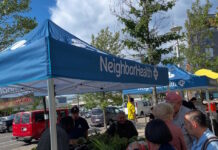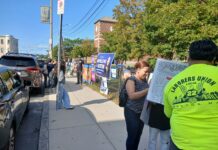Acquisition of 114 affordable units helps fight displacement in Eastie with innovative approach
By Elena Eberwein
SPECIAL TO EASTBOSTON.COM
(EAST BOSTON- January 21, 2023) A long-sought goal of preserving affordable housing in East Boston just became easier thanks to an innovative, collaborative project made possible by multiple players.
Late last year, a consortium of organizations came together to purchase a portfolio of properties to be set aside for affordable housing. The initiative began in the context of higher property values driving out low-income residents and workers.
The acquisition of 36 properties, containing 114 apartment units, by the newly formed East Boston Neighborhood Trust. It is the first Mixed Income Neighborhood Trust (MINT) in the state and will maintain the affordability of the acquired three-deckers for working families and low-income residents. This acquisition is a welcome step to combatting displacement in the neighborhood according to housing advocates, city officials and nonprofit leaders. The East Boston Community Development Corporation (CDC) is one of the key players in the trust.
As an East Boston native, Al Caldarelli, the CDC’s president and executive director, has seen the neighborhood change over decades. Since 1970, the CDC has worked to improve the lives of low income residents in East Boston. When Caldarelli began there in 1976, he primarily worked on senior housing, which enjoyed strong support. However, with the rapid development of the East Boston waterfront over the last two decades, working families have been priced out of the neighborhood.
It’s just not the waterfront that’s driving up prices. Old structures are recast into condominiums and land once used for industrial and commercial purposes are converted into “luxury apartments.” According to one estimate, the average rent for a 1-bedroom apartment in Boston is $3,000 which represents a six percent increase compared to the previous year. While East Boston rents trail the citywide average they remain out of reach for most of the traditional working class renters who raised families in East Boston.
To help combat this issue, the CDC purchased three-decker homes in Eastie it plans to rent as affordable units.
“What we’ve tried to do is make East Boston continue to be the welcoming community that it was,” said Caldarelli. “And what made it that way was that our three-deckers were affordable.”
He said the CDC was buying one or two three-deckers a year on average to transform into affordable units. So when he saw a portfolio of 36 properties go on the market, containing a total of 114 apartment units, he said, “We have to find a way to buy all of those.”
Through a joint effort of city officials, legislators, non-profits, “impact” investors, and other donors, the acquisition of the portfolio became reality.
The property portfolio was sold by The Grossman Companies and Hodara Real Estate Group for $47 million. The sale was also made possible by a $600,000 grant from The Boston Foundation.
The units are spread out throughout East Boston, in Eagle Hill, Central Square, Maverick Square, Orient Heights and the rapidly gentrifying Jeffries Point. The acquisition established Massachusetts’ first Mixed Income Neighborhood Trust (MINT), and will maintain the affordability of these three-deckers for working families and low-income residents.
The emphasis is on preservation not construction which is increasingly costly.
“We are not creating three-decker family units,” said Caldarelli. “We are reclaiming our affordable three-decker family units, we’re reclaiming them from the developers.”
The Model
The MINT model was developed by Trust Neighborhoods in 2019, and works to directly counteract displacement in communities..
“This model really is about how do you raise equity, so that low income neighborhoods that are seeing gentrification happen, have the money and the equity to go out and put in offers for properties and compete with private investors,” said Tanya Hahnel, the CDC’s Project Manager.
Hahnel said the second part of the MINT model differs from a traditional LLC structure. To ensure the control of the trust and governance remains with the community members after equity is raised, the stewardship committee is formed not only of real estate experts, but of members from social service and local nonprofits. For example, members from organizations such as City Life/Vida Urbana, the East Boston Social Centers, and PUEBLO will serve on the stewardship committee. The stewardship committee ensures that the goal of the portfolio continues to be creating anti-displacement housing and that these conversations can continue as the neighborhood changes over time.
“This [model] relies on finding investors who are willing to cede that control, because part of their mission is actually to empower local residents in gentrifying neighborhoods,” said Hahnel.
The Price Tag
Considering the competitive housing market in eastern Massachusetts and particularly in the city of Boston, securing funding was clearly a challenge.
To make the deal happen, the EBCDC needed to raise $50 million to purchase the portfolio at market price, plus money for renovations.
“We realized that the price tag was higher than what we could really afford with just us and the city in the traditional model,” said Hahnel.
This is when the plan started to involve more players. This included City Councilor Gabriela “Gigi” Coletta, who stepped up to see how she could help. Coletta grew up in a neighborhood where the landscape was dominated by three decker homes. During her campaign for city council last year she stressed the importance of affordability and the difference it made in her life.
Over the summer when city council members were reviewing ways to use American Rescue Plan Act (ARPA) funding to combat the effects of COVID-19, Coletta saw this project as a fit for the funding.
“One of the ways to mitigate impacts of COVID, was to keep people in place,” said Coletta.
Along with Councilor Kendra Lara, Chair of the Committee on Housing and Community Development, Coletta worked to garner support for this project. Both were able to secure $1 million of funding to put towards the acquisition.
“Because this was the first of its kind model, there was some skepticism,” said Coletta, “But we were able to break it down.”
Sealing the deal
After receiving funding from the city and city council, there was still an $8 million gap. But with the city council on board, the project began gaining more widespread support.
The CDC worked with Trust Neighborhoods to find equity impact investors to back the project. One of those investors was the Boston Impact Initiative, a nonprofit impact investing firm that invests in projects that support economic and racial justice.
Betty Francisco, CEO of the Boston Impact Initiative said, this acquisition, “takes housing stock out of the speculative market with the intent purpose of making it permanently affordable.”
The acquisition aligned with the mission of a second fund the nonprofit created in September to combat anti-displacement. Keeping families and small businesses in a community that is mostly Latino, also attracted the Boston Impact Initiative to the project, said Francisco.
“Across the state there are a lot of businesses of color being impacted by gentrification by developers coming in right and saying, ‘We’re gonna redevelop an entire building or area’ and it pushes out local small businesses that are the heart of many neighborhoods,” said Francisco. “They’re reflecting the culture of the neighborhood, they’re providing a service or a product that’s culturally relevant, and they’re getting pushed out. So there isn’t a lot of capital that’s specifically focused on anti-displacement efforts.”
The money was raised and the portfolio was closed on in October. Francisco said, “It was this really inspiring example of how multiple sectors in the funding world, both philanthropic, government, and private could come in to support and catalyze a deal like this.”
Rep. Adrian Madaro was also able to secure $900,000 in an economic spending bill that was passed, set aside for renovations of the units after the closing of the deal.
So what happens now?
The units in the portfolio that were vacant are now in the process of being renovated. For the units that are tenant occupied, Hahnel said, “We’re not kicking anybody out.”
Many of the tenant occupied units are roommate living arrangements.
“That’s the situation for a lot of the investor properties because you can get a lot more money if it’s roommates, right?” said Hahnel. As tenants move out, the properties will be renovated and income eligible families will move in.
The housing will remain affordable, so there will be limits on income based on average median income levels. There will also be units reserved for Section 8 and the homeless, said Caldarelli.
Caldarelli said his hope is that when these units are finished and tenants are moved in, “People will live together and they’ll become neighbors and that’s something that I always wanted to strive for.”
He added, “We’ll look for other opportunities, because I don’t think an opportunity like this is going to come up again.”
Related:
A Celebration of the East Boston Neighborhood Trust will take place on January 31, 2023
A list of the properties in the EBNT portfolio.
1/25/2023















